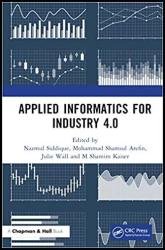 Название: Applied Informatics for Industry 4.0
Название: Applied Informatics for Industry 4.0Автор: Nazmul Siddique, Mohammad Shamsul Arefin, Julie Wall, M. Shamim Kaiser
Издательство: CRC Press
Год: 2023
Страниц: 338
Язык: английский
Формат: pdf (true)
Размер: 37.2 MB
Applied Informatics for Industry 4.0 combines the technologies of computer science and information science to assist in the management and processing of data to provide different types of services. Due to the adaptation of 4.0 IR-related technologies, applied informatics is playing a vital role in different sectors such as healthcare, complex system design and privacy-related issues. This book focuses on cutting edge research from the fields of informatics and complex industrial systems, and will cover topics including health informatics, bioinformatics, brain informatics, genomics and proteomics, data and network security and more. The text will appeal to beginners and advanced researchers in the fields of computer science, information sciences, electrical and electronic engineering and robotics.
Applied informatics combines the technologies of computer science and information sciences to assist in the management and processing of data to provide different types of services. Due to the adaptation of 4.0 IR related technologies, applied informatics is playing vital roles in different sectors.
A neural network is a sort of network that processes data like a human brain. The neurons are linked to each other among different units. The Artificial Neural Network (ANN) enables the machine using functions to make decisions on data for various purposes. In our experiment three different layers are linked: input layer, output layer and hidden layer. A backpropagation algorithm in ANN is used to adjust weights to ensure that the network is perfectly learned. Our experiment has applied PCA on the dataset using the Scikit-learn Machine Learning (ML) Library, where first we have scaled the dataset with the StandardScalar class and then fit it with appropriate transformation. After that, we have obtained the eigenvectors and eigenvalues of the principal components for five different variances (75, 80, 85, 90 and 95%). The number of components after reduction is shown in Table, along with the associated variances. On the dataset with different variances, we apply ANN and Random Forest Algorithm.
Скачать Applied Informatics for Industry 4.0